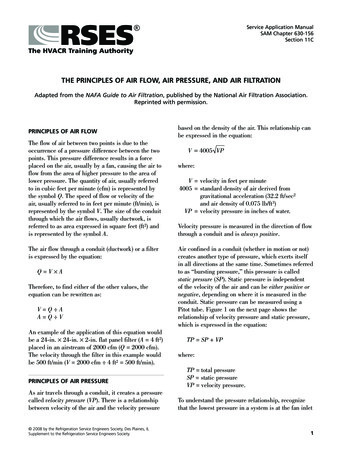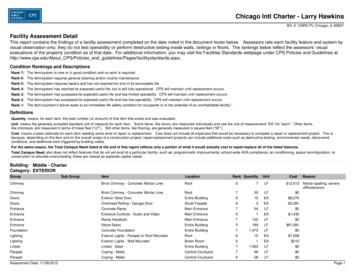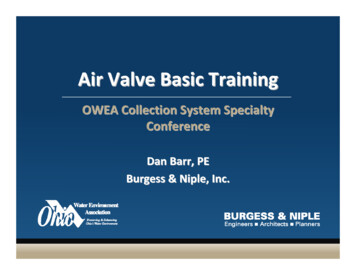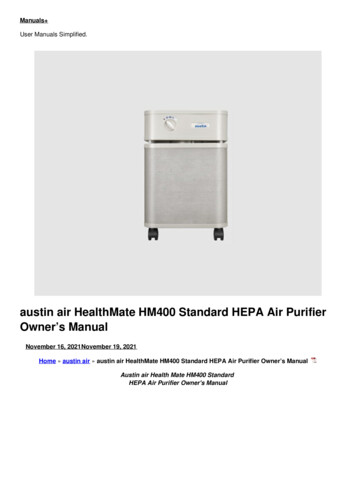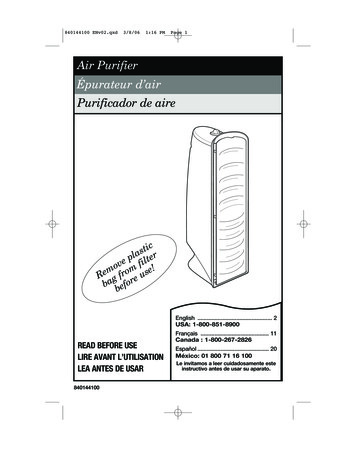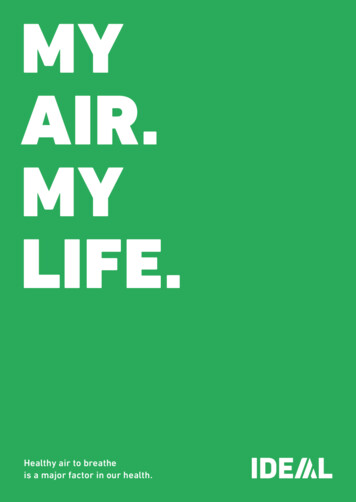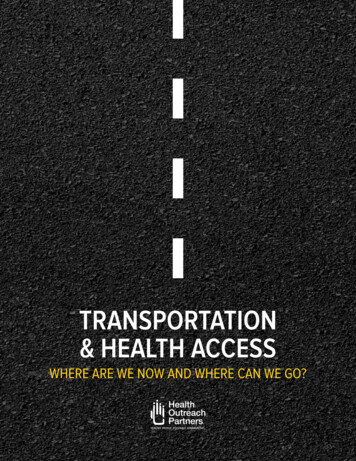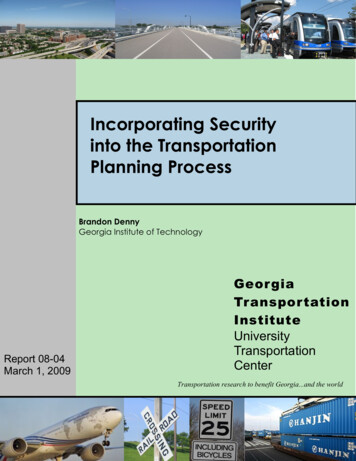
Transcription
Office of Transportation and Air QualityUS Environmental Protection Agency1
Overview: History of National Renewable Fuel Standards EPACT 2005 – RFS1 EISA 2007 – RFS2Key Highlights of the RFS2 RuleDetails on RFS2 General Structure Compliance Overview Renewable Fuel Pathway Determinations Renewable Feedstock ComplianceSetting the EISA Yearly StandardsOther Items of Interest Waiver Authorities Report to Congress - 204 206 - Antibacksliding / Tier 3 E15 DOE, USDA, BIWG Coordination / Activities Questions / Other Issues2
EPACT 2005 RFS1 National Standard 7.5 billion gallons EISA 2007 National Standard but with 4 categoriesof renewable fuels 2012 Full Implementation Significantly increased volumes ofrenewable fuel – to 36 billion gallons Obligation based on gasoline –onroad only 2022 Full Implementation General definition for renewablefuels 250 million gallons of cellulosicbiofuels Different qualification forcellulosic fuel - 2.5 Credits (RINs)per gallon of ethanol Expanded to on and off-road gasolineand diesel Explicit definitions for renewable fuelsto qualify Inclusion of specific types of waivers Legislation allows renewable fuels usedin Home Heating Oil and Jet Fuel tocount towards RFS2 program
Establishes four categories of renewable fuel volume standards: cellulosic biofuel biomass-based diesel advanced biofuel total renewable fuelChanges to the program include qualification requirements for renewable fuels and feedstocks Definitions for qualifying fuels / feedstocks for the categories Specifically defines cellulosic, biomass-based diesel, etc. Set minimum lifecycle GHG reduction thresholds for categories Established grandfathering allowances for renewable volumes from certain facilities Applies restrictions on types of feedstocks that can be used to make renewable fuel, andtypes of land that can be used to grow and harvest feedstocks Final rule set full 2010 EISA renewable fuels volume 12.95 Bg The RFS2 Regulations went into effect July 1, 2010. EPA developed a path for transitioning from RFS1 to RFS24
Four Separate Standards Biomass-Based Diesel: Minimum of 1 Bgal by 2012 and beyond E.g., Biodiesel, “renewable diesel” if fats and oils not co-processed withpetroleum Must meet a 50% lifecycle GHG reduction threshold Cellulosic Biofuel: Minimum of 16 Bgal by 2022 Renewable fuel produced from cellulose, hemicellulose, or lignin E.g., cellulosic ethanol, BTL diesel, green gasoline, etc. Must meet a 60% lifecycle GHG reduction threshold Advanced Biofuel: Minimum of 21 Bgal by 2022 (Minimum of 4 billion additional) Essentially anything but corn starch ethanol Includes cellulosic biofuels and biomass-based diesel Must meet a 50% lifecycle GHG reduction threshold Total Renewable Biofuel: 36 Bgal by 2022 (Minimum of 15 Bgal additional) Ethanol derived from corn starch – or any other qualifying renewable fuel Must meet 20% lifecycle GHG reduction threshold - Only applies to fuelproduced in new facilitiesLifecycle GHG reduction comparisons are based on a 2005 petroleum baseline as mandated by EISA.NOTE: Existing biofuel facilities (domestic and foreign) are not required to meet GHG thresholdfor conventional biofuel category – facilities are “Grandfathered.”5
ConventionalRenewableFuels Advanced BiomassBased DieselNon CellulosicAdvancedTotal TotalAdvanced RenewableFuel CellulosicAdvanced Total Advanced6
RINs are the currency of the RFS2program – used for complianceD valueMeaning under RFS1Meaning under RFS21Cellulosic biomass ethanolNot applicableRINS are generated by renewablefuel producer2Any renewable fuel that isnot cellulosic biomassethanolNot applicable3Not applicableCellulosic biofuel4Not applicableBiomass-based diesel5Not applicableAdvanced biofuel6Not applicableRenewable fuel7Not applicableCellulosic dieselTypes of Fuels are assigned a DCode – determined by EISAdefinition, restrictions, GHGevaluation, energy calculationRFS2 retains basic RIN handlingrequirements from the original RFSRINs follow product volumeRIN separation from volume mayonly be performed by an obligatedpartyRINs That Can Be Used To MeetEach Standard In RFS2StandardObligationAllowable D codesRIN credits have a two year life –year generated, plus one yearCellulosic biofuelRVOCB3 and 7*Biomass-based dieselRVOBBD4 and 7*Program continues to besupplemented by recordkeepingand attest requirementsAdvanced biofuelRVOAB3, 4, 5, and 7Renewable fuelRVORF3, 4, 5, 6, and 7** Plus certain RFS1 RINs for 20107
EPA Moderated Transaction System (EMTS): A closed, EPA-managed system thatprovides: 1) a mechanism for screening and2) a means for tracking RIN credits Screening process checks that theinformation provided by the RINgenerator is consistent with an existingregistrationRenewableProduction /ImportEPAScreeningFailPass RIN tracking process is similar to abanking system. Accounts are assigned to registeredusers. Transactions are conducted through EMTSwhich enforces business rules – e.g. aseller must have a sufficient accountbalance for a buyer to receive BuyOther RINOwnersSellImporters Attached RIN Separated RIN8
Act defines lifecycle Modeling applies specific definitional requirements in modeling, including indirectland use Modeling accounts for typical feedstock and fuel production pathway from whichsignificant production and contribution to RFS2 volumes are expected (2022) Accounts for uncertainty Modeled numerous fuel pathways Results extended to same fuel type and feedstock as a modeled pathway but withfeedstock production sources that were not included in the analysis (e.g., corn ethanoland soybean biodiesel produced in another country) Results extended to other fuel pathways with low risk of not complying – cellulosic,waste, other Threshold determinations for certain other pathways were not possible at time of finalrule because sufficient modeling or data not available For other fuel pathways not yet modeled, EPA provides a petition process throughwhich the fuel pathway can be analyzed and provided a compliance determination. EPA recognizes that the state of scientific knowledge continues to evolve in this area,therefore, the Agency is committing to further reassess determinations and lifecycleestimates going forward9
Renewable Fuel CategoryExample of Qualifying Renewable FuelCellulosic (60% GHG)Cellulosic ethanol and diesel fuel (Thermal /Biochemical from Stover and Switchgrass)Biomass-based diesel (50% GHG)Biodiesel from soy, canola, wastes oils, and algaeAdvanced biofuel (50% GHG)Ethanol from sugarcaneRenewable fuel(20% GHG or Grandfathered)Ethanol and Butanol from corn starch (coal-fireddoes not qualify)* Other pathways under evaluation – Palm, Sorghum, etc.10
11
EISA restricted where feedstocks can grow and be harvested for use in producingrenewable fuels for compliance with the RFS2 program Planted crops/crop residue from ag land cleared/cultivated prior to Dec. 2007 Planted trees/tree residue from nonfederal lands and tree plantationscleared/cultivated prior to Dec. 2007 Compliance Options for feedstocks from the Non Agricultural land / Forest land All renewable fuel producers using feedstocks from this sector can either1: Individually verify and qualify their feedstocks following specific recordkeeping andreporting requirements OR2: Opt to form and participate in a consortium that employs a third party to conduct averification program that acts to collectively verify and qualify these feedstocks forRFS2 renewable fuel production Compliance Approach for feedstocks from planted crops / agricultural land For US produced feedstocks, producers can comply under an aggregate complianceapproach For Foreign produced ag feedstocks, rule now provides option for other (non-U.S.)sources of feedstocks to use aggregate compliance if source region can providesufficient data to support aggregate analysis Canada recently petitioned EPA for an aggregate determination Otherwise, producers must verify using one of the options applied in the non-ag /forest sector12
2011 Total Advanced Standard - Maintained at 1.35 billion gallons Expected to be met in 2010 with biomass-based diesel compliance(0.65*1.5 0.975)13
EPA Sets EISA Standards Every Year Based on projected gasoline / diesel projectionsFormula used per regulations to determine the 4obligations in terms of a percentage of production andEISA volume standards applied for each categorySpring Proposal – Setting Following Year RFS2 VolumeStandards EISA Volumes converted into percent of gasoline and dieselproduction expected for following year Standards that apply to refiners, importers, gasoline blenders Cellulosic standard set based on EIA projections, our marketassessment and info through notice and comment Standards Announced Every November14
Cellulosic Biofuel Standard: Irrespective of the volumes required in the Act Administrator must set the cellulosic standard each November for the following year Evaluation based on an updated market analysis considering Detailed information from pilot and demonstration scale plants Energy Information Administration analysis Other publically and privately available market information, we If standard is set less than volume required in Act - EPA must make EPA-creditsavailable for sale to obligated parties at the greater of: 25 cent/gallon – or value greater than 25 c/gal based on EISA Formula: 3.00 per gallon less the wholesale price of gasoline (adjusted for inflation) Value was set at 1.13 for 2011 If the cellulosic standard is lowered, EPA can lower the volume standards for advancedbiofuel and total renewable fuel accordingly15
For the final rule, EPA will choose a single cellulosic valuefrom within proposed rangeEISA set other applicable volumes Biomass-based diesel, non-cellulosic advanced, renewablefuel and total advanced biofuel, and total renewable fuel EPA has authority to lower total renewable and totaladvance in whole or in part if cellulosic standard is lowered EPA proposed to maintain total advanced and totalrenewable fuel as specified in the statuteStandards set by law each year for forthcoming year EPA doing so by notice and commentOptimistic about late 2011 / 2012-2013 volume increases forcellulosic biofuels16
Reduce GHG Emissions by 138 MMT – equivalent of 27 million vehicles Displace 7% of petroleum gasoline and diesel consumption Increase Net Farm Income by 13 B Emissions and Air Quality: Increases in NOx, VOC, ethanol, acetaldehyde emissions Decreases in benzene and CO Emissions and air quality impacts vary by area Antibacksliding: Section 206 of EISA directs the agency to further evaluatepotential Air Quality impacts and to mitigate, to the extent possible, anyadverse impactsComprehensive Environmental Report: Section 204 – First report justrelease for public review and peer review – Required every 3 years17
What Ifs: EISA Waiver Authorities General: Anyone subject to requirements can petition waiver or relaxation of thefour standards Severe harm to the economy; Inadequate supply EPA must approve or disapprove within 90 days but requires opportunity fornotice and comment Limited to one year, but can be renewedBiomass Based Diesel: EPA can lower the standard in the Act If significant supply or other market circumstances lead to high prices Up to 15% or 30% if renewed Can reduce advanced biofuel and total renewable fuel standards accordinglyCellulosic Biofuel Standard: Irrespective of the volumes required in the Act Administrator must set the cellulosic standard each November for the followingyear “Based on" October EIA projections If cellulosic standard is set less than volume required in Act EPA must make EPACellulosic Biofuel Credits available for sale at the greater of 25 cent/gallon – or value greater than 25 c/gal based on calculation: 3.00 per gallon less the wholesale price of gasoline (adjusted for inflation)(Example 1: 3.00 – 2.82 .18 c/gal) - Since this is less than 25c/g, it would default to .25 c/galExample 2: (Example 1: 3.00 – 1.80 1.20 c/gal) - Since this is more than 25c/g, the creditwould sell for 1.20 c/gal EPA can reduce the standards for advanced biofuel and total renewable fuelaccordingly18
For Additional /index.htm Includes Factsheets RFS2 Rulemaking Package Preamble Regulations Regulatory Impact Analysis Links to Other Information Frequently Asked Questions Send new questions to:EPAFuelsPrograms@epa.gov19
E.g., Biodiesel, "renewable diesel" if fats and oils not co-processed with petroleum Must meet a 50% lifecycle GHG reduction threshold Cellulosic Biofuel: Minimum of 16 Bgal by 2022 Renewable fuel produced from cellulose, hemicellulose, or lignin E.g., cellulosic ethanol, BTL diesel, green gasoline, etc.



